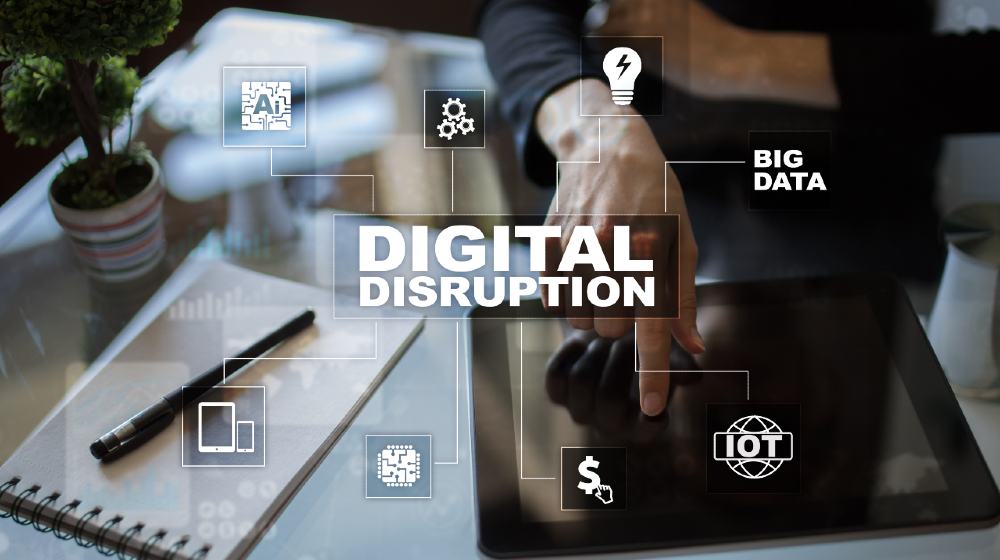COVID-19
Digital Disruption in a Post-COVID Landscape

Alex James, CTO of Ascent, discusses what will drive the next wave of digital disruption in a post-COVID landscape ‘Disruption’ is cited as the driving force behind many of today’s most celebrated business success stories.
As a startup objective, for instance, the concept implies many things, not least that the proposition is so innovative or prescient that it can overturn embedded market norms that previously seemed untouchable.
RELATED: The Pandemic Is Transforming to Digital Economy
Digital Disruption in a Post-COVID Landscape
Ever since it first gained widespread attention in the mid-1990s, the idea of ‘disruptive innovation’ has been appropriated the world over, when in reality, relatively few organizations can back their words up with bottom-line achievements. But taken at face value, delivering radical disruption has the potential to be hugely successful post-COVID.
Take the ‘Top 10 most popular Nasdaq stocks in 2020’, for example – a list inhabited by various game-changing industry ‘newcomers’ – think Amazon, Tesla, Nio, and Nikola.
Even more established brands among the group – Apple and Microsoft, for instance – have also brought huge innovation to their own way of doing things. Indeed, both of those companies have successfully reinvented themselves, with self-imposed disruption delivering massive returns.
Many of these tech companies and more besides have also demonstrated a remarkable level of resilience against the chaos wrought by COVID-19. As the Nasdaq itself explained last year, “COVID-19 has made “big-tech” even bigger.
It’s no secret that COVID-19 has significantly benefited companies such as Amazon and Zoom. But the virus and resulting work-from-home and contactless environment have also accelerated a structural and fundamental shift in the economy toward automation and digitization.”
But what’s next? In a post-COVID landscape, what will drive the next wave of disruption? Today, expectations have dramatically changed and innovators that can tap into the open-minded enthusiasm for digital innovation will be among future generations of tech unicorns.
Indeed, we need to leave behind the idea that ‘disruption’ is an attention-grabbing buzzword that’s been hijacked by businesses as a marketing ploy. Instead, organizations need to identify their own version of digital disruption as a post-COVID survival priority.
Previously, the concept was rooted in finding ways to do business or deliver services that could significantly boost efficiency, cost-effectiveness, and profit.
Now we turn to it for safety, because in a world where face-to-face engagement is compromised, digital channels have become the primary (and sometimes the only) customer engagement model, while automated processes become the main driver of productivity.
Among the other factors that will have a significant impact are the growing levels of digital literacy brought about by the urgent switch to remote working and the massive growth in the use of collaboration and communication technologies.
Organizations and individuals alike have been on a steep learning curve to adopt and exploit services that were previously irrelevant to their needs, or at best, were of peripheral importance.
As a result, long-term digital-led disruption means every organization needs to do some soul searching: Do you know where the value in your business is going to be and how you’re going to get there? How agile are you?
Have you got the right talent/skills/software needed for recovery? What are the most important investments to make that will allow your organization to thrive? And how many businesses can really identify how they can build value through data and advanced analytics when there’s never been a greater need for accurate and timely data-led insight?
Those organizations looking to create new business capabilities with data, software and the power of the cloud ecosystem need to redefine and strengthen their relationship with technology.
From software and data engineering to new product development, advanced analytics and data science, cloud, IoT, and ML, in a post-COVID landscape where the ability to interpret and visualize data has become much more prevalent, businesses that are able to connect data, software, and purpose to do something new, do something better, or both will be the disruptors.
Companies that can achieve this will do better than their competitors, grow more quickly and see an exponential commercial gain.
You Might Also Like:
- Retail Workers Leaving Jobs For Better Ones
- Timber! Lumber Prices Finally Going Down
- Child Care Access Was a Crisis Before COVID
Keep up to date with the latest finance news by following us on Facebook and Instagram.
Article Source: information-age.com



